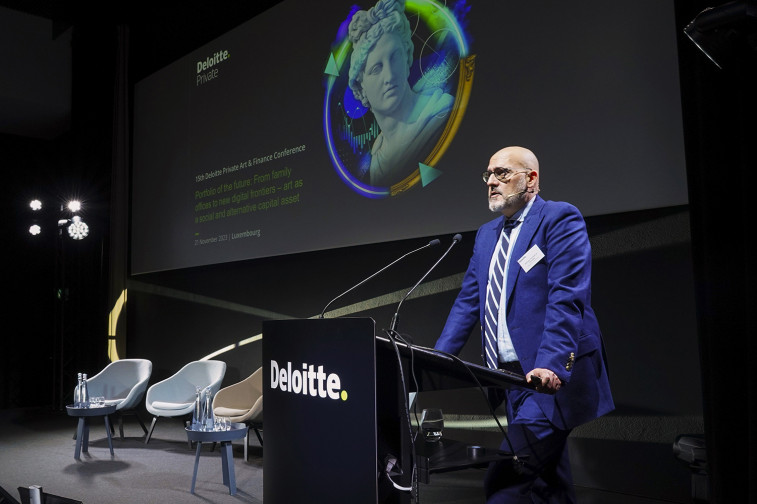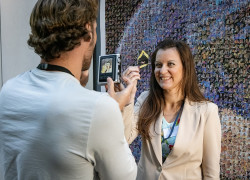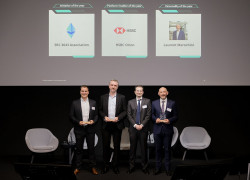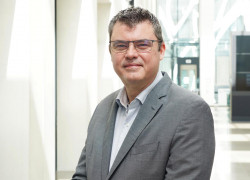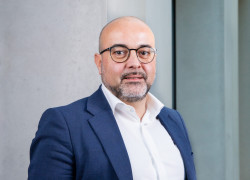Deloitte unveils 8th Art & Finance Report Art and collectibles crucial to the portfolio of the future
On November 21, Deloitte Luxembourg unveiled its 8th Deloitte Private and ArtTactic Art & Finance Report, presenting valuable insights on generational wealth transfer, sustainable and social impact investing, and the role of art and collectibles in a well-rounded portfolio of the future for family offices and wealth managers at large.
With its fifteenth iteration, the Art & Finance Conference confirms itself as a valuable and unique forum for the wealth management community, family offices, private banks, and the art and cultural sectors to gather. Following the theme of the Portfolio of the future: From family offices to new digital frontiers – art as a social and alternative capital asset, the latest edition of the conference focused more closely on family offices and the unique issues and priorities they face when dealing with art and collectibles.
“For more than 15 years, the Deloitte Private Art & Finance initiative has always encouraged collaboration between stakeholder groups at the intersection of art business, culture and finance,” says Adriano Picinati di Torcello, Director at Deloitte Luxembourg and Global Deloitte Art & Finance Coordinator. “We believe that by providing more transparency and awareness around obstacles, needs and drivers in the art and finance industry, we can catalyze dialogue between these stakeholders, inspire new models and solutions, and amplify the importance of culture in improving our lives and society.”
True to tradition, the biennial report was unveiled by its two leading authors: Adriano Picinati di Torcello, Global Deloitte Art & Finance Coordinator, and Anders Petterson, Managing Director of the research company ArtTactic.
In this year's edition of the Art & Finance Report, 55 leading experts shared their insights through 31 articles (13 from 9 different Deloitte offices) and 435 art and finance stakeholders (ranging from art professionals, family offices, wealth managers, to collectors and representing locales across the world) contributed to primary data and analyses. The report's global reach and the inclusion of a wide array of perspectives contribute to its status as an impartial and independent source of information within the art & finance industry.
A snapshot of this year’s key findings include:
- Global UHNWIs art and collectible wealth estimated to exceed US$2.2 trillion. In 2022, UHNWIs’ wealth associated with art and collectibles is estimated at US $2.174 trillion. This year’s reports predicts that this figure could grow to an estimated US$2.861 trillion in 2026, due to the increased number of UHNWIs across the world and their increased allocation of wealth to art and collectibles. As luxury assets become part of the art and finance landscape, a larger portion of wealth will be managed by the sector. We see already that approximately 63% of surveyed wealth managers have integrated art into their wealth management offering (67% among private banks and 60% among family offices).
- Wealth management offering. According to this year’s report, 89% of surveyed stakeholders believe art and collectibles should be part in a wealth management service offering (up from 65% in 2011); the highest percentage since the launch of the Art & Finance report twelve years ago. This significant shift in client expectations and wealth managers’ perception can be attributed to client demand for new products and services, a push towards holistic wealth management offering (94% among private banks and 81% amid family offices), recent technological and regulatory developments, and an increasing interest in the financial attributes of fine art and luxury collectibles. As a result, asset diversification is set to drive further demand for art-related assets. Notably, this year’s findings reveal a noteworthy change as financial value (41%) surpasses social value (36%) for the first time in 12 years, emerging as the second most important motivation among collectors.
- Generational wealth transfer and protection. Comprehending the unique and divergent generational needs and interests will be crucial for wealth managers navigating the generational handoff of assets and wealth. Market players must listen to NextGen collectors (35 years or younger), who will shape the future of the art and wealth management industry, and collaborate to create a long-term plan that includes both arts and estate planning as record-keeping still a manual process for most collectors surveyed (74%) and only 24% having a long-term plan for their collections.
- Culture and social impact investment. In this year’s report, we continue to monitor this new art and finance industry trends. While the G20 in India reaffirmed cultural and creative sectors as a major engine for sustainable socioeconomic recovery, there was not a significant increase in interest in art and culture-related sustainable impact investment among art professionals and wealth managers. However, social impact investment in art and culture is a primary motivation for 41% of NextGen collectors (and nearly a third of family offices) in the market.
- Art-secured lending. Despite higher interest rates, the report conservatively estimates that the overall size of outstanding loans against art could reach a market size between US$29.2 billion and US$34.1 billion in 2023, up 11% from 2022. The report posits that up to US$2.2 billion in revenue could be generated from the art-secured lending market in 2023, with Asia and Europe becoming strategic markets as the US market seems to be reaching maturity.
- The multifaceted appeal of fine art investments. According to Artnet’s index, art serves as a partial hedge during times of uncertainty, displaying mixed long-term performance. This unique social and alternative capital asset provides great opportunities for wealth managers to engage with their clients, fostering a distinctive relationship built on emotion, purpose, and financial considerations. In the current economic climate, the desire for a stable store of value outweighs the emphasis on return on investment.
- Fractional ownership as a new engagement model. Direct investment in art remains the most popular form of investment. However, in the last three years, worldwide curiosity in fractional art and collectibles investment has accelerated, particularly among NextGen collectors (representing 50% vs. 14% among older collectors) with this younger set expressing a strong interest. The Assets Under Management (AUM) is estimated to be more than US$1 billion in 2023. Several new initiatives have emerged, and, for the first time, some of these are being supervised by financial regulators in Europe, the US, and Asia. This suggests that we may have entered a new era in the development of a market for fractional ownership in art and collectibles, driven by a broader generational shift and interest in what we define as the sharing economy.
- Technology drives the art and finance sectors closer together. With advancements seen in the intersection between art and technology, we are likely at the precipice of a new age for the intersection of art and collectibles and finance – especially in how we engage, collect, monetize and protect these assets and in how we take them into the future. 64% of wealth managers surveyed this year said that technology could be a catalyst for incorporating art and collectible assets into their existing wealth management services. 80% of NextGen collectors believe in blockchain as an asset register for art and collectibles, and 79% see the potential of rapid developments around artwork identification technologies to address many of the current inefficiencies in today’s art market.
- Art-market modernization.76% of wealth managers, 82% of art professionals, and 70% of collectors agree that the art market needs to modernize its business practices. Among the key challenges are lack of transparency and provenance, issues related to authenticity, forgery and attribution, and exigency of international standards around professional qualifications in the art market. In this regard, approximately 80% of all surveyed stakeholders indicated that technology could be a catalyst for creating more transparency in the art market.
- Self-governance vs. more regulation: opinions are divided. 44% of wealth managers believe government regulation is the appropriate response to establishing trust and credibility in the art market. Among the surveyed family offices, 70% expressed that self-regulation would be the most appropriate way to address art market challenges, with only 30% favoring government regulation. In contrast, 50% of art professionals this year said they believe that regulation could play a crucial role in restoring trust (an increase from 36% in 2021). This is the highest percentage ever recorded, suggesting that stakeholders within the art industry increasingly view government intervention as a solution for restoring trust and credibility.
“Looking at the big picture, we observed an encouraging transformation in the wealth management sector. The global art market and the cultural and creative sectors are rapidly shaping new needs and opportunities at the intersection of art and finance,” says Adriano Picinati di Torcello. “The increasing recognition of the sector's importance is a positive sign toward a more inclusive, sustainable, and ambitious approach to arts and culture. We are finally at a turning point where art enters the wealth management spotlight as technology paves the way for promising results. Time is ripe, and Deloitte is here to help our clients make the most of opportunities.”
The 8th Deloitte Private and ArtTactic Art & Finance report was presented for the first time at the 15th Deloitte Private Art & Finance conference on 21 November 2023, demonstrating the report’s enduring importance to the wealth management industry around the globe. It can be downloaded from the Deloitte Luxembourg website at Art & Finance report - highlights in the art market | Deloitte
Communiqués liés
Deloitte Luxembourg nomme 11 nouveaux Partners et Managing D...
Déterminé à élever davantage ses ambitions, Deloitte Luxembourg a promu 11 p...
CBDC 2024: Thriving in an unpredictable environment
The 2024 Cross-Border Distribution Conference brought together over 750 industry...
MOMENTUM 2024 drives sustainable solutions forward
Deloitte’s annual MOMENTUM Conference fosters a dynamic exchange between indus...
Deloitte announces award winners at their 2024 Digital Asset...
The widespread implementation of digital assets in Luxembourg is both examined a...
Deep dive into the depths of the PSF ecosystem with Deloitte...
With the considerable growth of the Professionals of the Financial Sector (PSF) ...
Deloitte’s new acquisition deepens its foothold in Luxembo...
The consulting firm acquired Alto Advisory’s fintech practice on 1 January 202...
Il n'y a aucun résultat pour votre recherche

